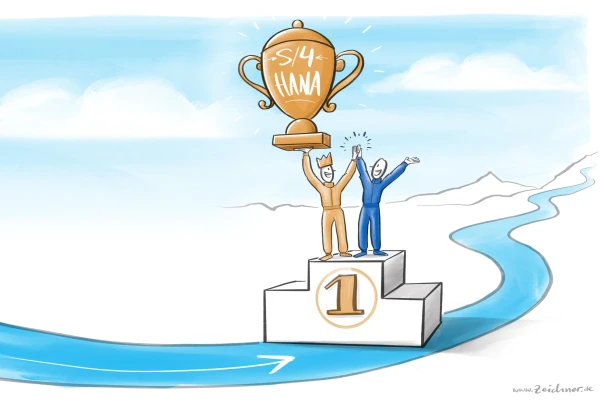SAP S/4HANA: WHY BUSINESSES SHOULD SWITCH TODAY RATHER THAN TOMORROW
The transition to SAP S/4HANA and the associated switch to the HANA database technology are currently hotly debated in the IT environment. Why is it so important for companies to deal with this issue today? And what do you need to bear in mind when making the transition? Answers from Joachim Gutheil, CEO of SPIRIT/21 GmbH, in an interview.
Which companies should switch to SAP S/4HANA and why?
The move to SAP S/4HANA makes sense for all companies, regardless of whether they are already using SAP software or using software from another provider and are thinking about switching. Thanks to its innovations, the new generation of SAP ERP software offers added value that cannot be ignored in the long run. For example, S/4HANA, the new digital core of SAP, offers a significantly improved user experience. The new SAP Fiori frontend allows users to easily access business processes even from mobile devices and thus act faster and more flexibly. At the same time, the in-memory technology of the HANA database enables faster access to large amounts of data„ die sich in Echtzeit verarbeiten, verknüpfen und analysieren lassen. Planungsläufe können in deutlich kürzeren Zyklen ausgeführt werden, wodurch aktuellere Daten zur Entscheidungsfindung zur Verfügung stehen. Das heißt, mit S/4HANA sind Unternehmen in der Lage, ihre IT-Umgebungen zu vereinfachen, Produktivitätsgewinne zu erzielen und ihre digitale Transformation weiter voranzutreiben.
In addition to these advantages, which clearly speak in favour of the switch, there is also the time pressure of SAP.
That is correct. SAP initially announced that it would discontinue maintenance of ERP Business Suite 7 in the coming years. In the meantime, the maintenance period for the central applications has been extended to 2027 and for extended maintenance to 2030, in order to give companies sufficient time to get into the new world in a targeted and efficient manner.
In your view, what is the optimal time for a change in this timeline? When should companies switch to SAP S/4HANA?
Of course, it always depends on the individual situation, but the sooner a company deals with the subject, the better. Basically, I can only recommend everyone to prepare early for the changeover, to carry out preliminary studies and to develop a roadmap as quickly as possible together with an IT consulting company with experience in SAP. Often, several steps within a preliminary project are necessary in order to create the necessary conditions for the changeover. Some companies do not yet have their current SAP systems up to the level required to move towards SAP S/4HANA. SPIRIT/21 will provide advice and support in all matters relating to the transition to S/4HANA. Once the timetable has been defined, there is usually enough time to make the necessary preparations and then take off.
How much time does a company need to allocate to migrate to SAP S/4HANA?
SAP talks about 12 to 18 months, which is also in line with our experience from different projects. However, the complexity of the implementation is often underestimated. The project duration depends primarily on two factors: the initial situation of the ERP system and the size of the company. Furthermore, it must be clarified in advance how much process diversity and the proportion of custom code is, and whether the entire SAP system landscape is to be consolidated and harmonized within the project. Answers to these and similar questions will significantly influence the time factor, as will the decision whether to replace the existing systems completely and implement S/4HANA from scratch or And that decision affects not only the duration of the project, but also the costs associated with it.
How can the time and cost of S/4HANA transformation be reduced?
Many companies are making a gradual changeover. I think this is a good scenario for reducing costs. For example, it might make sense to switch to the HANA database first in order to increase performance and enable real-time evaluations. A second option is to use SAP Fiori as part of the ERP Business Suite. These are the first steps towards digitization without the company having to switch to S/4HANA. In the next step, processes can be optimized and prepared for the changeover.
How can companies prepare for the SAP S/4HANA transformation?
The changeover to S/4HANA requires a structured approach. Our experience from various customer projects shows that it is absolutely necessary to carry out a preliminary study before switching to SAP S/4HANA. The aim of this preliminary study is to work out, together with the project partner, in which scenario the changeover should take place. Whether the migration should be carried out in stages or whether it is more effective to take a big step into the new world and thereby take advantage of the opportunity to consolidate or re-establish the entire SAP landscape. These questions are analysed by our consultants during the preliminary study.
What is the case for the greenfield approach and what is the case for the brownfield approach?
The switch to S/4HANA is a step into a new world. It not only offers the opportunity to modernise processes, but also the opportunity to cut off old brains. Many companies today use a highly developed ERP system, which has been supplemented by their own developments over the years. With S/4HANA, which offers many process-related enhancements, it is now possible to fall back on best-practice processes, replace in-house developments and go back to the SAP standard. This simplifies release changes and upgrade projects and significantly reduces the associated costs. The greenfield approach thus offers the opportunity to switch off legacy systems, in-house developments and third-party products and to map them within SAP. The brownfield approach, on the other hand, is more compatible with the company’s cost burden. Here, the implementation is first based on the existing processes. Optimizing them in a subsequent step is often the more complex way. Therefore, I generally recommend switching to the greenfield approach as far as the framework conditions allow. Ultimately, it is often a question of budget which implementation scenario is chosen.
Wie kann SPIRIT/21 bei der Einführung von S/4HANA unterstützen?
Wir beraten unsere Kunden durchgängig während des gesamten Umstellungsprozesses. Im Rahmen der Vorstudie setzen wir auf verschiedene Analyse-Tools, mit denen wir herausfinden, wo das Unternehmen aktuell mit seinem ERP-System steht. Dazu zählen zum Beispiel SAP Business Scenario Recommendations for SAP S/4HANA, SAP Transformation Navigator for SAP S/4HANA oder der SAP Readiness Check for SAP S/4HANA. Wir erhalten Reports, die uns aufzeigen, wie groß der Eigenentwicklungsanteil ist und ob bestimmte Programme überhaupt schon HANA-fähig sind. Daraus kann oft schon sehr gut abgeleitet werden, welches Umstiegsszenario für den Kunden infrage kommt. Auch sehen wir welche Aufwände, Lizenzkosten und Investitionen damit verbunden sind und wie lange das Projekt vermutlich dauern wird. Auf Basis der Vorstudienergebnisse und unserer Erfahrung aus den unterschiedlichsten Projekten erarbeiten wir dann die Konzeptvorschläge für die Einführung. So entsteht eine individuelle Roadmap, mit der der Projektpartner in seine neue Zielumgebung gehen kann.
What happens after the timetable is in place?
As soon as the roadmap has been defined, implementation can begin. Here we have had good experiences with the SAP Model Companies. These preconfigured, industry-specific reference solutions are immediately ready for use and help speed up implementation considerably. Recently, it has also been possible to assemble your own model company from several Model Companies. The great advantage is that companies do not “match” the new processes against their existing processes, but against the Model Company’s best practice processes. In this way, they can save time and money during process analysis. by four to five months.
Do questions about the operating model also play a role in the transformation?
When switching to SAP S/4HANA, the focus is initially on the application side. Nevertheless, we already try to look at the bigger picture in the preliminary studies. Of course, this also includes questions relating to future operations, such as how and where the new system should be operated in the future. Whether it is implemented in your own data center or whether it might be more cost-effective to outsource operations and purchase services via a managed service contract from an external service provider. It also makes sense to look at other scenarios, such as what opportunities cloud services offer in this context and how the company will position itself in the future. should.
What comes after the implementation of SAP S/4HANA?
As a Managed Service Provider, SPIRIT/21 supports SAP user companies even after “go-live”. By purchasing Application and Managed Services, they can relieve their own employees of day-to-day operations and routine tasks in the SAP environment. This gives companies the freedom to deal with new topics and to build up the necessary S/4HANA know-how. Special training offers from SPIRIT/21 help.
Mehr erfahren

SAP services from SPIRIT/21: Whether new implementation, carve-in/out, migrations or the operation of your systems - we have the experience and skills for your SAP project

We like to compare S/4HANA transformation projects to a rally in which we successfully guide you to the finish line.

What changes and innovations can customers expect when switching to the new SAP S/4HANA 2023 release? A brief insight into the new release strategy and highlights of the new release at application level.
Ursula Ilg
Unternehmenskommunikation
Phone: +491726325439
E-Mail: uilg@spirit21.com
Ursula has extensive experience in communication and marketing, both in corporate environments and medium-sized businesses. She is happy to assist you with any inquiries in these areas.
